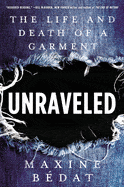Style Points is a weekly column about how fashion intersects with the wider world.
Maxine Bédat swears she began with a fairly modest aim: to tell the life story of a pair of jeans, from a humble cotton plant nestled in the soil to the flares hanging in your closet—and even extending into their potential afterlife as discarded landfill junk. “It’s not that I set out to connect the dots,” she says of the continent-crisscrossing reporting that took her everywhere from a Texas farm to a factory in Bangladesh and a landfill in Ghana. Nevertheless, those disparate dots come together to tell a story of consumption and waste in her new book Unraveled: The Life and Death of a Garment. “In telling the story,” she says, “one does begin to see how these things are connected.”
Every exploration took Bédat down a different path, whether it was researching how female garment workers in 19th-century New York City helped develop modern-day labor protections in the wake of the Triangle Shirtwaist Fire, or the way the history of cotton production was intertwined with the history of slavery in America. “The story of our clothing helps explain the story of our world,” she says. “I didn’t totally understand that when I set out, but I certainly became more aware of it as I was writing.”
Bédat is the founder and director of the New Standard Institute, a nonprofit that describes itself as a “think and do tank” for raising the fashion industry’s consciousness. She previously co-founded the ethical e-commerce site Zady, and her experience on that side of the industry has informed her activism and writing. An issue like workplace safety in factories, for example, “is so shrouded in secrecy, because the companies themselves don’t know and are scared to know” how their business actually operates, she says. She remembers going to a fashion conference where attendees could fill out an anonymous survey about their concerns: “What was keeping these brand managers up at night? It was that there was going to be a factory disaster in a factory that they didn’t even know that they were sourcing from.”
Another little-discussed side of fashion she discovered was the afterlife of the clothes we donate, which are often sent to landfills and even incinerated. “There is a complete lack of knowledge, from the companies themselves and even from the donation centers, of what happens to clothing once it’s been either donated or thrown out,” she says. “We have this assumption that it’s going someplace where people will value it, but we have to move beyond that assumption.” While many brands have recently started their own recycling programs to combat this problem, she says that only a “very, very small percentage can actually get recycled into other garments. The bulk of it is sorted and then baled and shipped off. It’s just a complete fabrication at the moment, this idea of circularity. I think it’s one of the more dangerous and insidious concepts out there.”
Before her stints at NSI and Zady, Bédat was a lawyer, which might explain her ability to systematically dismantle some of fashion’s most beloved greenwashing language. She takes issue with the term “sustainability” itself, arguing at one point that there’s no such thing as sustainable fashion, just lower-impact fashion. “It’s not that I want to pooh-pooh legitimate efforts,” she says. “We need them and we need to encourage [them.] But when we label things as ‘sustainable fashion,’ we ignore the most important relationship, which is not how the garment is made. It is our relationship to it; how often we are wearing it. That is what drives resource reduction.” Bédat is more bullish on upcycling, which has been used with great success by everyone from Balenciaga to inventive young designers like Conner Ives and Patrick McDowell. “If we are to have an industry that exists within the resources of the planet,” she says, “it’s going to be from using existing material.”
Another, less tangible problem Bédat taps into is the way the fashion industry has conditioned us to want ever-newer things. At one point, she notes, we might only have seen desirable images of potential purchases once a month in magazines. Now, thanks to the Internet and social media, we’re seeing them constantly (and people are already shopping their way through the post-pandemic rush.) When I mention in passing that people naturally want new things, Bédat points out the extent to which that’s actually down to conditioning over nature. “It’s not like we want new stuff all the time. We’re just sent a lot of messages to buy things all the time,” she says. Social media then turns into a self-reinforcing feedback loop, prodding us to value “cost per like” over cost per wear. She has particularly stinging words for celebrities and influencers who urge their followers to constantly buy, buy, buy: “Getting a brand deal is their way to have the house next to the billionaire, but what is that actually doing for the world?”
That said, our personal consumption is far from the only factor at play—there’s also the matter of what we can accomplish with our own grassroots tactics. The last chapter of the book focuses on political action people can take, refreshingly moving beyond the “carbon footprint” model of placing all responsibility on individuals. Corporations, she notes, want us to “see ourselves as consumers over and above our role as citizens.” Bédat doesn’t want despair to be the takeaway from her book; she wants to give us solutions as well. What she was trying to do “was to explain where things are now in an unvarnished way, but in, so doing, also explain that we have the power to change these things.
“The book,” she insists, “is not meant to be a downer.”
This content is created and maintained by a third party, and imported onto this page to help users provide their email addresses. You may be able to find more information about this and similar content at piano.io




